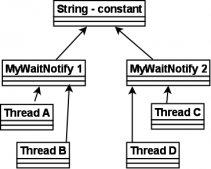前言
在学习java的过程中,想必大家都一定学习过异常这个篇章,异常的基本特性和使用这里就不再多讲了。什么是异常?我不知道大家都是怎么去理解的,我的理解很简单,那就是不正常的情况,比如我现在是个男的,但是我却有着女人所独有的东西,在我看来这尼玛肯定是种异常,简直不能忍。想必大家都能够理解看懂,并正确使用。
但是,光学会基本异常处理和使用不够的,在工作中出现异常并不可怕,有时候是需要使用异常来驱动业务的处理,例如: 在使用唯一约束的数据库的时候,如果插入一条重复的数据,那么可以通过捕获唯一约束异常duplicatekeyexception来进行处理,这个时候,在server层中就可以向调用层抛出对应的状态,上层根据对应的状态再进行处理,所以有时候异常对业务来说,是一个驱动方式。
有的捕获异常之后会将异常进行输出,不知道细心的同学有没有注意到一点,输出的异常是什么东西呢?
下面来看一个常见的异常:
|
1
2
3
4
5
6
7
8
9
10
11
12
13
14
15
16
17
18
19
20
21
22
23
|
java.lang.arithmeticexception: / by zero at greenhouse.exceptiontest.testexception(exceptiontest.java:16) at sun.reflect.nativemethodaccessorimpl.invoke0(native method) at sun.reflect.nativemethodaccessorimpl.invoke(nativemethodaccessorimpl.java:39) at sun.reflect.delegatingmethodaccessorimpl.invoke(delegatingmethodaccessorimpl.java:25) at java.lang.reflect.method.invoke(method.java:597) at org.junit.runners.model.frameworkmethod$1.runreflectivecall(frameworkmethod.java:44) at org.junit.internal.runners.model.reflectivecallable.run(reflectivecallable.java:15) at org.junit.runners.model.frameworkmethod.invokeexplosively(frameworkmethod.java:41) at org.junit.internal.runners.statements.invokemethod.evaluate(invokemethod.java:20) at org.junit.runners.blockjunit4classrunner.runchild(blockjunit4classrunner.java:76) at org.junit.runners.blockjunit4classrunner.runchild(blockjunit4classrunner.java:50) at org.junit.runners.parentrunner$3.run(parentrunner.java:193) at org.junit.runners.parentrunner$1.schedule(parentrunner.java:52) at org.junit.runners.parentrunner.runchildren(parentrunner.java:191) at org.junit.runners.parentrunner.access$000(parentrunner.java:42) at org.junit.runners.parentrunner$2.evaluate(parentrunner.java:184) at org.junit.runners.parentrunner.run(parentrunner.java:236) at org.junit.runner.junitcore.run(junitcore.java:157) at com.intellij.junit4.junit4ideatestrunner.startrunnerwithargs(junit4ideatestrunner.java:68) at com.intellij.rt.execution.junit.ideatestrunner$repeater.startrunnerwithargs(ideatestrunner.java:47) at com.intellij.rt.execution.junit.junitstarter.preparestreamsandstart(junitstarter.java:242) at com.intellij.rt.execution.junit.junitstarter.main(junitstarter.java:70) |
一个空指针异常:
|
1
2
3
4
5
6
7
8
9
10
11
12
13
14
15
16
17
18
19
20
21
22
23
|
java.lang.nullpointerexception at greenhouse.exceptiontest.testexception(exceptiontest.java:16) at sun.reflect.nativemethodaccessorimpl.invoke0(native method) at sun.reflect.nativemethodaccessorimpl.invoke(nativemethodaccessorimpl.java:39) at sun.reflect.delegatingmethodaccessorimpl.invoke(delegatingmethodaccessorimpl.java:25) at java.lang.reflect.method.invoke(method.java:597) at org.junit.runners.model.frameworkmethod$1.runreflectivecall(frameworkmethod.java:44) at org.junit.internal.runners.model.reflectivecallable.run(reflectivecallable.java:15) at org.junit.runners.model.frameworkmethod.invokeexplosively(frameworkmethod.java:41) at org.junit.internal.runners.statements.invokemethod.evaluate(invokemethod.java:20) at org.junit.runners.blockjunit4classrunner.runchild(blockjunit4classrunner.java:76) at org.junit.runners.blockjunit4classrunner.runchild(blockjunit4classrunner.java:50) at org.junit.runners.parentrunner$3.run(parentrunner.java:193) at org.junit.runners.parentrunner$1.schedule(parentrunner.java:52) at org.junit.runners.parentrunner.runchildren(parentrunner.java:191) at org.junit.runners.parentrunner.access$000(parentrunner.java:42) at org.junit.runners.parentrunner$2.evaluate(parentrunner.java:184) at org.junit.runners.parentrunner.run(parentrunner.java:236) at org.junit.runner.junitcore.run(junitcore.java:157) at com.intellij.junit4.junit4ideatestrunner.startrunnerwithargs(junit4ideatestrunner.java:68) at com.intellij.rt.execution.junit.ideatestrunner$repeater.startrunnerwithargs(ideatestrunner.java:47) at com.intellij.rt.execution.junit.junitstarter.preparestreamsandstart(junitstarter.java:242) at com.intellij.rt.execution.junit.junitstarter.main(junitstarter.java:70) |
大家有没有发现一个特点,就是异常的输出是中能够精确的输出异常出现的地点,还有后面一大堆的执行过程类调用,也都打印出来了,这些信息从哪儿来呢? 这些信息是从栈中获取的,在打印异常日志的时候,会从栈中去获取这些调用信息。能够精确的定位异常出现的异常当然是好,但是我们有时候考虑到程序的性能,以及一些需求时,我们有时候并不需要完全的打印这些信息,并且去方法调用栈中获取相应的信息,是有性能消耗的,对于一些性能要求高的程序,我们完全可以在这一个方面为程序性能做一个提升。
所以如何避免输出这些堆栈信息呢? 那么自定义异常就可以解决这个问题:
首先,自动异常需要继承runtimeexception, 然后,再通过是重写fillinstacktrace, tostring 方法, 例如,下面我定义一个appexception异常:
|
1
2
3
4
5
6
7
8
9
10
11
12
13
14
15
16
17
18
19
20
21
22
23
24
25
26
27
28
29
30
31
32
33
34
35
36
37
38
39
40
41
42
43
44
45
46
47
48
|
package com.green.monitor.common.exception;import java.text.messageformat;/** * 自定义异常类 */public class appexception extends runtimeexception { private boolean issuccess = false; private string key; private string info; public appexception(string key) { super(key); this.key = key; this.info = key; } public appexception(string key, string message) { super(messageformat.format("{0}[{1}]", key, message)); this.key = key; this.info = message; } public appexception(string message, string key, string info) { super(message); this.key = key; this.info = info; } public boolean issuccess() { return issuccess; } public string getkey() { return key; } public void setkey(string key) { this.key = key; } public string getinfo() { return info; } public void setinfo(string info) { this.info = info; } @override public throwable fillinstacktrace() { return this; } @override public string tostring() { return messageformat.format("{0}[{1}]",this.key,this.info); }} |
那么为什么要重写fillinstacktrace, 和 tostring 方法呢? 我们首先来看源码是怎么一回事.
|
1
2
3
4
5
6
7
8
9
10
11
12
13
14
15
16
17
18
19
20
21
22
23
24
25
26
27
28
29
30
31
32
33
34
35
36
37
38
39
40
41
42
43
44
45
46
47
48
49
50
51
52
|
public class runtimeexception extends exception { static final long serialversionuid = -7034897190745766939l; /** constructs a new runtime exception with <code>null</code> as its * detail message. the cause is not initialized, and may subsequently be * initialized by a call to {@link #initcause}. */ public runtimeexception() { super(); } /** constructs a new runtime exception with the specified detail message. * the cause is not initialized, and may subsequently be initialized by a * call to {@link #initcause}. * * @param message the detail message. the detail message is saved for * later retrieval by the {@link #getmessage()} method. */ public runtimeexception(string message) { super(message); } /** * constructs a new runtime exception with the specified detail message and * cause. <p>note that the detail message associated with * <code>cause</code> is <i>not</i> automatically incorporated in * this runtime exception's detail message. * * @param message the detail message (which is saved for later retrieval * by the {@link #getmessage()} method). * @param cause the cause (which is saved for later retrieval by the * {@link #getcause()} method). (a <tt>null</tt> value is * permitted, and indicates that the cause is nonexistent or * unknown.) * @since 1.4 */ public runtimeexception(string message, throwable cause) { super(message, cause); } /** constructs a new runtime exception with the specified cause and a * detail message of <tt>(cause==null ? null : cause.tostring())</tt> * (which typically contains the class and detail message of * <tt>cause</tt>). this constructor is useful for runtime exceptions * that are little more than wrappers for other throwables. * * @param cause the cause (which is saved for later retrieval by the * {@link #getcause()} method). (a <tt>null</tt> value is * permitted, and indicates that the cause is nonexistent or * unknown.) * @since 1.4 */ public runtimeexception(throwable cause) { super(cause); } } |
runtimeexception是继承exception,但是它里面去只是调用了父类的方法,本身是没有做什么其余的操作。那么继续看exception里面是怎么回事呢?
|
1
2
3
4
5
6
7
8
9
10
11
12
13
14
15
16
17
18
19
20
21
22
23
24
25
26
27
28
29
30
31
32
33
34
35
36
37
38
39
40
41
42
43
44
45
46
47
48
49
50
51
52
53
54
55
56
|
public class exception extends throwable { static final long serialversionuid = -3387516993124229948l; /** * constructs a new exception with <code>null</code> as its detail message. * the cause is not initialized, and may subsequently be initialized by a * call to {@link #initcause}. */ public exception() { super(); } /** * constructs a new exception with the specified detail message. the * cause is not initialized, and may subsequently be initialized by * a call to {@link #initcause}. * * @param message the detail message. the detail message is saved for * later retrieval by the {@link #getmessage()} method. */ public exception(string message) { super(message); } /** * constructs a new exception with the specified detail message and * cause. <p>note that the detail message associated with * <code>cause</code> is <i>not</i> automatically incorporated in * this exception's detail message. * * @param message the detail message (which is saved for later retrieval * by the {@link #getmessage()} method). * @param cause the cause (which is saved for later retrieval by the * {@link #getcause()} method). (a <tt>null</tt> value is * permitted, and indicates that the cause is nonexistent or * unknown.) * @since 1.4 */ public exception(string message, throwable cause) { super(message, cause); } /** * constructs a new exception with the specified cause and a detail * message of <tt>(cause==null ? null : cause.tostring())</tt> (which * typically contains the class and detail message of <tt>cause</tt>). * this constructor is useful for exceptions that are little more than * wrappers for other throwables (for example, {@link * java.security.privilegedactionexception}). * * @param cause the cause (which is saved for later retrieval by the * {@link #getcause()} method). (a <tt>null</tt> value is * permitted, and indicates that the cause is nonexistent or * unknown.) * @since 1.4 */ public exception(throwable cause) { super(cause); }} |
从源码中可以看到, exception里面也是直接调用了父类的方法,和runtimeexception一样,自己其实并没有做什么。 那么直接来看throwable里面是怎么一回事:
|
1
2
3
4
5
6
7
8
9
10
11
12
13
14
15
16
17
18
19
20
21
22
23
24
25
26
27
28
29
30
31
32
33
34
35
36
37
38
39
40
41
42
43
44
45
46
47
48
49
50
51
52
53
54
55
56
57
58
59
60
61
62
63
64
65
66
67
68
69
70
71
72
73
74
75
76
77
78
79
80
81
82
83
84
85
86
87
88
89
90
|
public class throwable implements serializable { public throwable(string message) { fillinstacktrace(); detailmessage = message; } /** * fills in the execution stack trace. this method records within this * <code>throwable</code> object information about the current state of * the stack frames for the current thread. * * @return a reference to this <code>throwable</code> instance. * @see java.lang.throwable#printstacktrace() */ public synchronized native throwable fillinstacktrace(); /** * provides programmatic access to the stack trace information printed by * {@link #printstacktrace()}. returns an array of stack trace elements, * each representing one stack frame. the zeroth element of the array * (assuming the array's length is non-zero) represents the top of the * stack, which is the last method invocation in the sequence. typically, * this is the point at which this throwable was created and thrown. * the last element of the array (assuming the array's length is non-zero) * represents the bottom of the stack, which is the first method invocation * in the sequence. * * <p>some virtual machines may, under some circumstances, omit one * or more stack frames from the stack trace. in the extreme case, * a virtual machine that has no stack trace information concerning * this throwable is permitted to return a zero-length array from this * method. generally speaking, the array returned by this method will * contain one element for every frame that would be printed by * <tt>printstacktrace</tt>. * * @return an array of stack trace elements representing the stack trace * pertaining to this throwable. * @since 1.4 */ public stacktraceelement[] getstacktrace() { return (stacktraceelement[]) getourstacktrace().clone(); } private synchronized stacktraceelement[] getourstacktrace() { // initialize stack trace if this is the first call to this method if (stacktrace == null) { int depth = getstacktracedepth(); stacktrace = new stacktraceelement[depth]; for (int i=0; i < depth; i++) stacktrace[i] = getstacktraceelement(i); } return stacktrace; } /** * returns the number of elements in the stack trace (or 0 if the stack * trace is unavailable). * * package-protection for use by sharedsecrets. */ native int getstacktracedepth(); /** * returns the specified element of the stack trace. * * package-protection for use by sharedsecrets. * * @param index index of the element to return. * @throws indexoutofboundsexception if <tt>index < 0 || * index >= getstacktracedepth() </tt> */ native stacktraceelement getstacktraceelement(int index); /** * returns a short description of this throwable. * the result is the concatenation of: * <ul> * <li> the {@linkplain class#getname() name} of the class of this object * <li> ": " (a colon and a space) * <li> the result of invoking this object's {@link #getlocalizedmessage} * method * </ul> * if <tt>getlocalizedmessage</tt> returns <tt>null</tt>, then just * the class name is returned. * * @return a string representation of this throwable. */ public string tostring() { string s = getclass().getname(); string message = getlocalizedmessage(); return (message != null) ? (s + ": " + message) : s; } |
从源码中可以看到,到throwable就几乎到头了, 在fillinstacktrace() 方法是一个native方法,这方法也就是会调用底层的c语言,返回一个throwable对象, tostring 方法,返回的是throwable的简短描述信息, 并且在getstacktrace 方法和 getourstacktrace 中调用的都是native方法getstacktraceelement, 而这个方法是返回指定的栈元素信息,所以这个过程肯定是消耗性能的,那么我们自定义异常中的重写tostring方法和fillinstacktrace方法就可以不从栈中去获取异常信息,直接输出,这样对系统和程序来说,相对就没有那么”重”, 是一个优化性能的非常好的办法。那么如果出现自定义异常那么是什么样的呢?请看下面吧:
|
1
2
3
4
5
6
7
8
9
|
@test public void testexception(){ try { string str =null; system.out.println(str.charat(0)); }catch (exception e){ throw new appexception("000001","空指针异常"); } } |
那么在异常异常的时候,系统将会打印我们自定义的异常信息:
|
1
2
|
000001[空指针异常]process finished with exit code -1 |
所以特别简洁,优化了系统程序性能,让程序不这么“重”, 所以对于性能要求特别要求的系统。赶紧自己的自定义异常吧!
总结
以上就是这篇文章的全部内容了,希望本文的内容对大家的学习或者工作具有一定的参考学习价值,如果有疑问大家可以留言交流,谢谢大家对服务器之家的支持。
原文链接:https://wangchangchung.github.io/2018/04/18/Java自定义异常打印非堆栈信息/

















